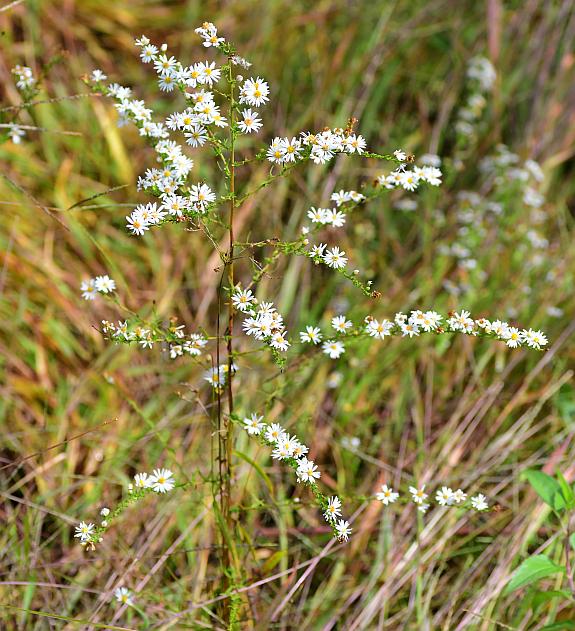Symphyotrichum racemosum (Elliott) G.L. Nesom
Small White Aster, Fragile-Stem American Aster

Native
CC = 5
CW = -3
MOC = 31
SRank = S2
© SRTurner
Symphyotrichum racemosum (Elliott) G.L. NesomSmall White Aster, Fragile-Stem American Aster | |
 |
Native CC = 5 CW = -3 MOC = 31 SRank = S2 |
© SRTurner |
|
Family - Asteraceae/Astereae Habit - Perennial forb, often somewhat colonial from relatively long, slender, branched rhizomes. Stem - Ascending to erect, to 1.0 m, usually solitary, usually with several spreading to ascending branches mostly above the midpoint, sparsely pubescent with short, curled hairs toward the tip, these usually in longitudinal lines or bands, usually glabrous toward the base or sometimes nearly throughout.
Leaves - Alternate, simple, mostly sessile. Basal and/or lower stem leaves usually absent from the flowering stems, sessile or with a short, poorly differentiated petiole, the blade 1-4 cm long, 0.4-1.0 cm wide, oblanceolate, tapered at the base, rounded or angled to a bluntly or sharply pointed tip, the margins with spreading to forward-pointing hairs and usually scalloped, the surfaces glabrous, the secondary veins on the leaf undersurface often difficult to distinguish from the veinlets, forming an irregular network of elongated areoles. Median and upper stem leaves progressively smaller, the larger ones occasionally withered by flowering time, sessile, the base sometimes slightly expanded but not clasping the stem, the blades 1-6 cm long, linear to narrowly oblanceolate, the margins entire or sparsely toothed, angled or tapered at the base, angled or tapered to a sharply pointed tip, otherwise similar to the lower stem leaves.
Inflorescences - Appearing as panicles with relatively long, loosely ascending to spreading or arched branches (these mostly with the heads solitary or in small, loose clusters toward the branch tips), the heads appearing mostly long-stalked and usually oriented in various directions, the bracts along the ultimate branches 0.1-1.0 cm long, often relatively numerous, more or less leaflike, linear, noticeably shorter than the adjacent foliage leaves.
Heads - Heads mostly 0.6-1.0 cm in diameter (including the extended ray corollas) at flowering. Involucre 2.5-4.0 mm long, cup-shaped to slightly bell-shaped when fresh (sometimes becoming obconical when pressed), the bracts in 4 or 5 unequal, overlapping series. Involucral bracts linear-lanceolate to narrowly oblong-oblanceolate, angled or tapered at the usually sharply pointed tip, lacking a bristlelike or spinelike point at the ascending tip, the slender midvein broadened gradually in the apical 1/2-3/4 into a narrowly elliptic (4-10 times as long as wide), green tip, the outer surface glabrous, the margins often slightly irregular and sparsely hairy.
Florets - Ray florets 12-20 in usually 1 or 2 series, pistillate, the corollas well developed, 3-6 mm long, white (rarely pink). Disc florets 15-25, perfect, the corollas 2.5-3.5 mm long, the slender portion of the tube noticeably shorter than the slightly expanded apical portion, the lobes 0.4-0.7 mm long, 30-45 percent of the total length of the expanded portion. Pappus bristles 2.5-3.5 mm long, white or off-white.
Fruits - Achenes 1.0-1.8 mm long, with 4 or 5 faint, longitudinal ribs, gray to tan, sparsely to moderately hairy, the hairs lacking swollen bases. Flowering - August - October. Habitat - Bottomland forests, swamps, moist prairie swales, streambanks, pond margins, fens, sloughs, ditches, railroads, roadsides, moist open disturbed areas. Origin - Native to the U.S. Lookalikes - Numerous other small white asters, especially S. lateriflorum and S. dumosum. Other info. - This small white aster has a rather peculiar distribution in Missouri, being found within a doughnut-shaped region covering much of the state. It is probably most prevalent in the southeastern part of the state. Beyond Missouri its range is scattered throughout most of the eastern half of the U.S. The plant is idenfified by its racemes of white flowering heads and small, narrow leaves. However, the taxonomy of this complex is not well understood and differentiation from lookalikes is difficult. Inflorescence aspects, peduncle length, and appearance of the involucral bracts have all been used for differentiation but the differences are subtle and sometimes found in mixed states on a single plant. To further muddy the waters, varieties have been named, with Missouri plants apparently belonging to var. subdumosum. Photographs taken at Duck Creek Conservation Area, 10-5-2021 (SRTurner). |